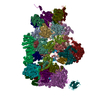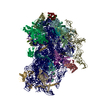[English] 日本語
 Yorodumi
Yorodumi- EMDB-10773: Structure of a human 48S translational initiation complex - eIF3bgi -
+ Open data
Open data
- Basic information
Basic information
| Entry | Database: EMDB / ID: EMD-10773 | ||||||||||||
|---|---|---|---|---|---|---|---|---|---|---|---|---|---|
| Title | Structure of a human 48S translational initiation complex - eIF3bgi | ||||||||||||
 Map data Map data | |||||||||||||
 Sample Sample |
| ||||||||||||
 Keywords Keywords | eIF3 / ribosome / translation / initiation complex | ||||||||||||
| Function / homology |  Function and homology information Function and homology informationviral translational termination-reinitiation / eukaryotic translation initiation factor 3 complex, eIF3e / eukaryotic translation initiation factor 3 complex, eIF3m / IRES-dependent viral translational initiation / translation reinitiation / formation of cytoplasmic translation initiation complex / eukaryotic translation initiation factor 3 complex / cytoplasmic translational initiation / multi-eIF complex / eukaryotic 43S preinitiation complex ...viral translational termination-reinitiation / eukaryotic translation initiation factor 3 complex, eIF3e / eukaryotic translation initiation factor 3 complex, eIF3m / IRES-dependent viral translational initiation / translation reinitiation / formation of cytoplasmic translation initiation complex / eukaryotic translation initiation factor 3 complex / cytoplasmic translational initiation / multi-eIF complex / eukaryotic 43S preinitiation complex / eukaryotic 48S preinitiation complex / regulation of translational initiation / Formation of the ternary complex, and subsequently, the 43S complex / Ribosomal scanning and start codon recognition / Translation initiation complex formation / Formation of a pool of free 40S subunits / GTP hydrolysis and joining of the 60S ribosomal subunit / L13a-mediated translational silencing of Ceruloplasmin expression / translation initiation factor binding / translation initiation factor activity / translational initiation / receptor tyrosine kinase binding / negative regulation of ERK1 and ERK2 cascade / cytoplasmic stress granule / molecular adaptor activity / microtubule / postsynaptic density / mRNA binding / synapse / nucleolus / structural molecule activity / RNA binding / extracellular exosome / nucleoplasm / membrane / cytosol / cytoplasm Similarity search - Function | ||||||||||||
| Biological species |  Homo sapiens (human) Homo sapiens (human) | ||||||||||||
| Method | single particle reconstruction / cryo EM / Resolution: 6.0 Å | ||||||||||||
 Authors Authors | Brito Querido J / Sokabe M | ||||||||||||
| Funding support |  United Kingdom, United Kingdom,  United States, 3 items United States, 3 items
| ||||||||||||
 Citation Citation |  Journal: Science / Year: 2020 Journal: Science / Year: 2020Title: Structure of a human 48 translational initiation complex. Authors: Jailson Brito Querido / Masaaki Sokabe / Sebastian Kraatz / Yuliya Gordiyenko / J Mark Skehel / Christopher S Fraser / V Ramakrishnan /   Abstract: A key step in translational initiation is the recruitment of the 43 preinitiation complex by the cap-binding complex [eukaryotic initiation factor 4F (eIF4F)] at the 5' end of messenger RNA (mRNA) to ...A key step in translational initiation is the recruitment of the 43 preinitiation complex by the cap-binding complex [eukaryotic initiation factor 4F (eIF4F)] at the 5' end of messenger RNA (mRNA) to form the 48 initiation complex (i.e., the 48). The 48 then scans along the mRNA to locate a start codon. To understand the mechanisms involved, we used cryo-electron microscopy to determine the structure of a reconstituted human 48 The structure reveals insights into early events of translation initiation complex assembly, as well as how eIF4F interacts with subunits of eIF3 near the mRNA exit channel in the 43 The location of eIF4F is consistent with a slotting model of mRNA recruitment and suggests that downstream mRNA is unwound at least in part by being "pulled" through the 40 subunit during scanning. | ||||||||||||
| History |
|
- Structure visualization
Structure visualization
| Movie |
 Movie viewer Movie viewer |
|---|---|
| Structure viewer | EM map:  SurfView SurfView Molmil Molmil Jmol/JSmol Jmol/JSmol |
| Supplemental images |
- Downloads & links
Downloads & links
-EMDB archive
| Map data |  emd_10773.map.gz emd_10773.map.gz | 37.1 MB |  EMDB map data format EMDB map data format | |
|---|---|---|---|---|
| Header (meta data) |  emd-10773-v30.xml emd-10773-v30.xml emd-10773.xml emd-10773.xml | 19.8 KB 19.8 KB | Display Display |  EMDB header EMDB header |
| Images |  emd_10773.png emd_10773.png | 227.8 KB | ||
| Masks |  emd_10773_msk_1.map emd_10773_msk_1.map | 476.8 MB |  Mask map Mask map | |
| Filedesc metadata |  emd-10773.cif.gz emd-10773.cif.gz | 6.5 KB | ||
| Others |  emd_10773_additional.map.gz emd_10773_additional.map.gz emd_10773_half_map_1.map.gz emd_10773_half_map_1.map.gz emd_10773_half_map_2.map.gz emd_10773_half_map_2.map.gz | 381 MB 382 MB 382 MB | ||
| Archive directory |  http://ftp.pdbj.org/pub/emdb/structures/EMD-10773 http://ftp.pdbj.org/pub/emdb/structures/EMD-10773 ftp://ftp.pdbj.org/pub/emdb/structures/EMD-10773 ftp://ftp.pdbj.org/pub/emdb/structures/EMD-10773 | HTTPS FTP |
-Validation report
| Summary document |  emd_10773_validation.pdf.gz emd_10773_validation.pdf.gz | 705.5 KB | Display |  EMDB validaton report EMDB validaton report |
|---|---|---|---|---|
| Full document |  emd_10773_full_validation.pdf.gz emd_10773_full_validation.pdf.gz | 705.1 KB | Display | |
| Data in XML |  emd_10773_validation.xml.gz emd_10773_validation.xml.gz | 18.5 KB | Display | |
| Data in CIF |  emd_10773_validation.cif.gz emd_10773_validation.cif.gz | 22.1 KB | Display | |
| Arichive directory |  https://ftp.pdbj.org/pub/emdb/validation_reports/EMD-10773 https://ftp.pdbj.org/pub/emdb/validation_reports/EMD-10773 ftp://ftp.pdbj.org/pub/emdb/validation_reports/EMD-10773 ftp://ftp.pdbj.org/pub/emdb/validation_reports/EMD-10773 | HTTPS FTP |
-Related structure data
| Related structure data |  6ybtMC  6ybdC  6ybsC  6ybvC  6ybwC  6zmwC M: atomic model generated by this map C: citing same article ( |
|---|---|
| Similar structure data |
- Links
Links
| EMDB pages |  EMDB (EBI/PDBe) / EMDB (EBI/PDBe) /  EMDataResource EMDataResource |
|---|---|
| Related items in Molecule of the Month |
- Map
Map
| File |  Download / File: emd_10773.map.gz / Format: CCP4 / Size: 476.8 MB / Type: IMAGE STORED AS FLOATING POINT NUMBER (4 BYTES) Download / File: emd_10773.map.gz / Format: CCP4 / Size: 476.8 MB / Type: IMAGE STORED AS FLOATING POINT NUMBER (4 BYTES) | ||||||||||||||||||||||||||||||||||||||||||||||||||||||||||||
|---|---|---|---|---|---|---|---|---|---|---|---|---|---|---|---|---|---|---|---|---|---|---|---|---|---|---|---|---|---|---|---|---|---|---|---|---|---|---|---|---|---|---|---|---|---|---|---|---|---|---|---|---|---|---|---|---|---|---|---|---|---|
| Projections & slices | Image control
Images are generated by Spider. | ||||||||||||||||||||||||||||||||||||||||||||||||||||||||||||
| Voxel size | X=Y=Z: 1.074 Å | ||||||||||||||||||||||||||||||||||||||||||||||||||||||||||||
| Density |
| ||||||||||||||||||||||||||||||||||||||||||||||||||||||||||||
| Symmetry | Space group: 1 | ||||||||||||||||||||||||||||||||||||||||||||||||||||||||||||
| Details | EMDB XML:
CCP4 map header:
| ||||||||||||||||||||||||||||||||||||||||||||||||||||||||||||
-Supplemental data
-Mask #1
| File |  emd_10773_msk_1.map emd_10773_msk_1.map | ||||||||||||
|---|---|---|---|---|---|---|---|---|---|---|---|---|---|
| Projections & Slices |
| ||||||||||||
| Density Histograms |
-Additional map: #1
| File | emd_10773_additional.map | ||||||||||||
|---|---|---|---|---|---|---|---|---|---|---|---|---|---|
| Projections & Slices |
| ||||||||||||
| Density Histograms |
-Half map: #2
| File | emd_10773_half_map_1.map | ||||||||||||
|---|---|---|---|---|---|---|---|---|---|---|---|---|---|
| Projections & Slices |
| ||||||||||||
| Density Histograms |
-Half map: #1
| File | emd_10773_half_map_2.map | ||||||||||||
|---|---|---|---|---|---|---|---|---|---|---|---|---|---|
| Projections & Slices |
| ||||||||||||
| Density Histograms |
- Sample components
Sample components
-Entire : Eukaryotic translation initiation factor
| Entire | Name: Eukaryotic translation initiation factor |
|---|---|
| Components |
|
-Supramolecule #1: Eukaryotic translation initiation factor
| Supramolecule | Name: Eukaryotic translation initiation factor / type: complex / ID: 1 / Parent: 0 / Macromolecule list: all |
|---|---|
| Source (natural) | Organism:  Homo sapiens (human) Homo sapiens (human) |
-Macromolecule #1: Eukaryotic translation initiation factor 3 subunit A
| Macromolecule | Name: Eukaryotic translation initiation factor 3 subunit A / type: protein_or_peptide / ID: 1 / Number of copies: 1 / Enantiomer: LEVO |
|---|---|
| Source (natural) | Organism:  Homo sapiens (human) Homo sapiens (human) |
| Molecular weight | Theoretical: 163.179531 KDa |
| Sequence | String: DVMKSKKHRT WQKIHEPIML KYLELCVDLR KSHLAKEGLY QYKNICQQVN IKSLEDVVRA YLKMAEEKTE AAKEESQQMV LDIEDLDNI QTPESVLLSA VSGEDTQDRT DRLLLTPWVK FLWESYRQCL DLLRNNSRVE RLYHDIAQQA FKFCLQYTRK A EFRKLCDN ...String: DVMKSKKHRT WQKIHEPIML KYLELCVDLR KSHLAKEGLY QYKNICQQVN IKSLEDVVRA YLKMAEEKTE AAKEESQQMV LDIEDLDNI QTPESVLLSA VSGEDTQDRT DRLLLTPWVK FLWESYRQCL DLLRNNSRVE RLYHDIAQQA FKFCLQYTRK A EFRKLCDN LRMHLSQIQR HHNQSTAINL NNPESQSMHL ETRLVQLDSA ISMELWQEAF KAVEDIHGLF SLSKKPPKPQ LM ANYYNKV STVFWKSGNA LFHASTLHRL YHLSREMRKN LTQDEMQRMS TRVLLATLSI PITPERTDIA RLLDMDGIIV EKQ RRLATL LGLQAPPTRI GLINDMVRFN VLQYVVPEVK DLYNWLEVEF NPLKLCERVT KVLNWVREQP EKEPELQQYV PQLQ NNTIL RLLQQVSQIY QSIEFSRLTS LVPFVDAFQL ERAIVDAARH CDLQVRIDHT SRTLSFGSDL NYATREDAPI GPHLQ SMPS EQIRNQLTAM SSVLAKALEV IKPAHILQEK EEQHQLAVTA YLKNSRKEHQ RILARRQTIE ERKERLESLN IQREKE ELE QREAELQKVR KAEEERLRQE AKEREKERIL QEHEQIKKKT VRERLEQIKK TELGAKAFKD IDIEDLEELD PDFIMAK QV EQLEKEKKEL QERLKNQEKK IDYFERAKRL EEIPLIKSAY EEQRIKDMDL WEQQEEERIT TMQLEREKAL EHKNRMSR M LEDRDLFVMR LKAARQSVYE EKLKQFEERL AEERHNRLEE RKRQRKEERR ITYYREKEEE EQRRAEEQML KEREERERA ERAKREEELR EYQERVKKLE EVERKKRQRE LEIEERERRR EEERRLGDSS LSRKDSRWGD RDSEGTWRKG PEADSEWRRG PPEKEWRRG EGRDEDRSHR RDEERPRRLG DDEDREPSLR PDDDRVPRRG MDDDRGPRRG PEEDRFSRRG ADDDRPSWRN T DDDRPPRR IADEDRGNWR HADDDRPPRR GLDEDRGSWR TADEDRGPRR GMDDDRGPRR GGADDERSSW RNADDDRGPR RG LDDDRGP RRGMDDDRGP RRGMDDDRGP RRGMDDDRGP RRGLDDDRGP WRNADDDRIP RRGAEDDRGP WRNMDDDRLS RRA DDDRFP RRGDDSRPGP WRPLVKPGGW REKEKAREES WGPPRESRPS EEREWDREKE RDRDNQDREE NDKDPERERD RERD VDRED RFRRPRDEGG WRRGPAEESS SWRDSSRRDD RDRDDRRRER DDRRDLRERR DLRDDRDRRG PPLRSEREEV SSWRR ADDR KDDRVEERDP PRRVPPPALS RDRERDRDRE REGEKEKASW RAEKDRESLR RTKNETDEDG WTTVRR UniProtKB: Eukaryotic translation initiation factor 3 subunit A |
-Macromolecule #2: Eukaryotic translation initiation factor 3 subunit I
| Macromolecule | Name: Eukaryotic translation initiation factor 3 subunit I / type: protein_or_peptide / ID: 2 / Number of copies: 1 / Enantiomer: LEVO |
|---|---|
| Source (natural) | Organism:  Homo sapiens (human) Homo sapiens (human) |
| Molecular weight | Theoretical: 36.543773 KDa |
| Sequence | String: MKPILLQGHE RSITQIKYNR EGDLLFTVAK DPIVNVWYSV NGERLGTYMG HTGAVWCVDA DWDTKHVLTG SADNSCRLWD CETGKQLAL LKTNSAVRTC GFDFGGNIIM FSTDKQMGYQ CFVSFFDLRD PSQIDNNEPY MKIPCNDSKI TSAVWGPLGE C IIAGHESG ...String: MKPILLQGHE RSITQIKYNR EGDLLFTVAK DPIVNVWYSV NGERLGTYMG HTGAVWCVDA DWDTKHVLTG SADNSCRLWD CETGKQLAL LKTNSAVRTC GFDFGGNIIM FSTDKQMGYQ CFVSFFDLRD PSQIDNNEPY MKIPCNDSKI TSAVWGPLGE C IIAGHESG ELNQYSAKSG EVLVNVKEHS RQINDIQLSR DMTMFVTASK DNTAKLFDST TLEHQKTFRT ERPVNSAALS PN YDHVVLG GGQEAMDVTT TSTRIGKFEA RFFHLAFEEE FGRVKGHFGP INSVAFHPDG KSYSSGGEDG YVRIHYFDPQ YFE FEFEA UniProtKB: Eukaryotic translation initiation factor 3 subunit I |
-Macromolecule #3: Eukaryotic translation initiation factor 3 subunit B
| Macromolecule | Name: Eukaryotic translation initiation factor 3 subunit B / type: protein_or_peptide / ID: 3 / Number of copies: 1 / Enantiomer: LEVO |
|---|---|
| Source (natural) | Organism:  Homo sapiens (human) Homo sapiens (human) |
| Molecular weight | Theoretical: 92.593414 KDa |
| Sequence | String: MQDAENVAVP EAAEERAEPG QQQPAAEPPP AEGLLRPAGP GAPEAAGTEA SSEEVGIAEA GPESEVRTEP AAEAEAASGP SESPSPPAA EELPGSHAEP PVPAQGEAPG EQARDERSDS RAQAVSEDAG GNEGRAAEAE PRALENGDAD EPSFSDPEDF V DDVSEEEL ...String: MQDAENVAVP EAAEERAEPG QQQPAAEPPP AEGLLRPAGP GAPEAAGTEA SSEEVGIAEA GPESEVRTEP AAEAEAASGP SESPSPPAA EELPGSHAEP PVPAQGEAPG EQARDERSDS RAQAVSEDAG GNEGRAAEAE PRALENGDAD EPSFSDPEDF V DDVSEEEL LGDVLKDRPQ EADGIDSVIV VDNVPQVGPD RLEKLKNVIH KIFSKFGKIT NDFYPEEDGK TKGYIFLEYA SP AHAVDAV KNADGYKLDK QHTFRVNLFT DFDKYMTISD EWDIPEKQPF KDLGNLRYWL EEAECRDQYS VIFESGDRTS IFW NDVKDP VSIEERARWT ETYVRWSPKG TYLATFHQRG IALWGGEKFK QIQRFSHQGV QLIDFSPCER YLVTFSPLMD TQDD PQAII IWDILTGHKK RGFHCESSAH WPIFKWSHDG KFFARMTLDT LSIYETPSMG LLDKKSLKIS GIKDFSWSPG GNIIA FWVP EDKDIPARVT LMQLPTRQEI RVRNLFNVVD CKLHWQKNGD YLCVKVDRTP KGTQGVVTNF EIFRMREKQV PVDVVE MKE TIIAFAWEPN GSKFAVLHGE APRISVSFYH VKNNGKIELI KMFDKQQANT IFWSPQGQFV VLAGLRSMNG ALAFVDT SD CTVMNIAEHY MASDVEWDPT GRYVVTSVSW WSHKVDNAYW LWTFQGRLLQ KNNKDRFCQL LWRPRPPTLL SQEQIKQI K KDLKKYSKIF EQKDRLSQSK ASKELVERRR TMMEDFRKYR KMAQELYMEQ KNERLELRGG VDTDELDSNV DDWEEETIE FFVTEEIIPL GNQE UniProtKB: Eukaryotic translation initiation factor 3 subunit B |
-Experimental details
-Structure determination
| Method | cryo EM |
|---|---|
 Processing Processing | single particle reconstruction |
| Aggregation state | particle |
- Sample preparation
Sample preparation
| Buffer | pH: 7.4 |
|---|---|
| Vitrification | Cryogen name: ETHANE / Chamber humidity: 100 % / Instrument: FEI VITROBOT MARK IV |
- Electron microscopy
Electron microscopy
| Microscope | FEI TITAN KRIOS |
|---|---|
| Image recording | Film or detector model: FEI FALCON III (4k x 4k) / Detector mode: INTEGRATING / Average exposure time: 1.0 sec. / Average electron dose: 107.0 e/Å2 |
| Electron beam | Acceleration voltage: 300 kV / Electron source:  FIELD EMISSION GUN FIELD EMISSION GUN |
| Electron optics | Illumination mode: FLOOD BEAM / Imaging mode: BRIGHT FIELD |
| Experimental equipment |  Model: Titan Krios / Image courtesy: FEI Company |
- Image processing
Image processing
| Startup model | Type of model: OTHER |
|---|---|
| Final reconstruction | Resolution.type: BY AUTHOR / Resolution: 6.0 Å / Resolution method: FSC 0.143 CUT-OFF / Number images used: 144882 |
| Initial angle assignment | Type: OTHER |
| Final angle assignment | Type: OTHER |
 Movie
Movie Controller
Controller





















 Z (Sec.)
Z (Sec.) Y (Row.)
Y (Row.) X (Col.)
X (Col.)





















































